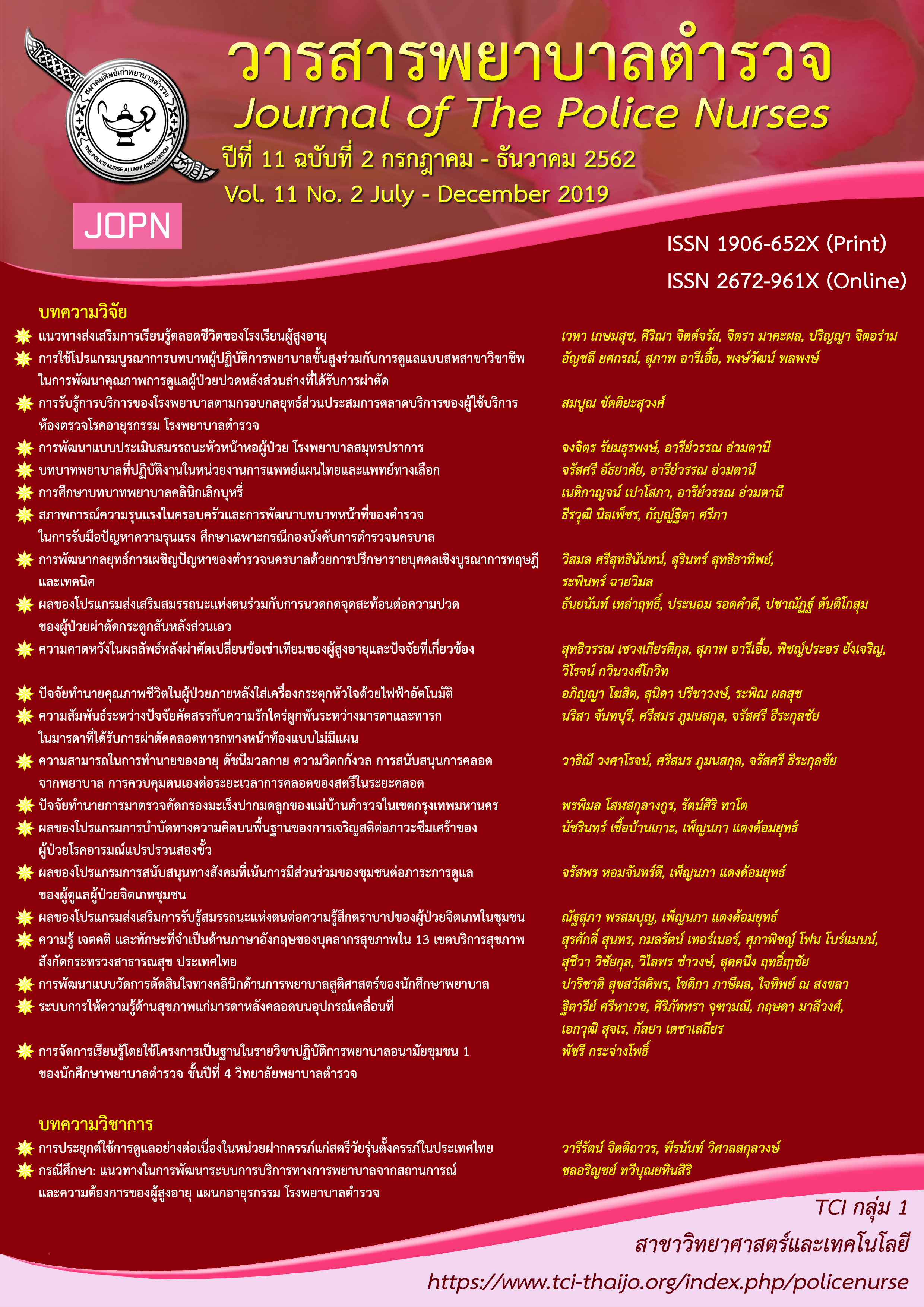THE EFFECT OF SELF-EFFICACY PROMOTING PROGRAM COMBINED WITH REFLEXOLOGY ON PAIN IN PATIENTS WITH LAMINECTOMY
Keywords:
self-efficacy promoting program, laminectomy, pain, foot reflexologyAbstract
The purpose of this quasi-experimental research was to study the effect of self-efficacy promoting program combined with reflexology on postoperative pain in patients with Laminectomy. Adult patients aged 18 - 59 years with degenerative disc disease at surgical ward, Police General Hospital were recruited. Both control (n = 22) and the experimental (n = 22) groups were matched by age, gender, level of lumbar disc, and dose of pain killer medication. The control group received the conventional care. The experimental group received the self-efficacy promoting program combined with foot reflexology developed based on the concept of Bandura. The self-efficacy program consisted of 4 principle sources of verbal persuasion, vicarious experience, enactive mastery experience and physiological and affective states. The instruments for collecting data were the Visual Analog Scale and post-operative self-efficacy questionnaire used to monitor the manipulation. The reliability coefficient was .93. Data were analyzed using descriptive statistics and one-way repeated measure ANOVA.
The results revealed that the mean score of post-operative pain after laminectomy at days 3, 4, and 5 in the experimental group was significantly lower than those in the control group (p < .05). However, post-operative pain days 1 and day 2 of the experimental groups and the control groups were difference but were not statistically significant.
Downloads
References
Bandura, A. (1997). Self-efficacy: The exercise of control. New York, NY: W.H. Freeman and company.
Burns, N., & Grove, S. K. (2009). The practice of nurse research: Appraisal, synthesis,and generation of evidence (6 ed.). St. Loius, MO: Elsevier Saunder.
Chidambaran, V., Zhang, X., Martin, L. J., Ding, L., Weirauch, M. T., Geisler, K., . . . Ji, H. (2017). DNA methylation at the mu-1 opioid receptor gene (OPRM1) promoter predicts preoperative, acute, and chronic postsurgical pain after spine fusion. Pharmacogenomics and Personalized Medicine, 9(10), 157-168.
Chobarunsitti, S. (2008). Effect of self-efficacy enhancement on patients’ post abdominal surgery recovery at Phaphuttabath hospital, Saraburi (Master of nursing science program, adult nursing). Faculty of Nursing, Mahidol University, Nakhon Pathom.
Den-Boer, J. J., Oostendor, R., Beems, T., Munneke, M., & Evers, A. (2006). Continued disability and pain after lumbar disc surgery: The role of cognitive-behavioral factors. Pain, 123(1-2), 45-52.
Devin, C. J., & McGirt, M. J. (2015). Best evident in multimodal pain management in spine surgery and means of assessing postoperative pain and functional outcomes. Journal of Clinical Neuroscience, 22(6), 930-938.
Gauger, V. T., et al. (2009). Epidural analgesia compared with intravenous analgesia after pediatric posterior spinal fusion. Journal of Pediatric Orthopaedics, 29(6), 588-593.
Gosegrineramon, S. (2010). Effect of self-efficacy enhancement program on perceived self-efficacy, activities of daily living and bowel movement among patients with lumbar spine surgery (Master of nursing science program, adult nursing). Faculty of Nursing, Mahidol University, Nakhon Pathom.
Lakasing, E., & Lawrence, D. (2010). When to use reflexology. Alternative medicine, 20(1), 16-19.
Mannion, A. F., Elfering, A., Staerkle, R., Junge, A., Grob, D., Dvorak, J., . . . Boos, N. (2007). Predictors of multidimensional outcome after spinal surgery. European Spine Journal, 16, 777-786.
Mathiesen, O., Dahl, B., Thomsen, B. A., Kitter, B., Sonne, N., Dahl, J. B., & Kehlet, H. (2013). A comprehensive multimodal pain treatment reduces opioid consumption after multilevel spine surgery. European Spine Journal, 22(9), 2089-2096.
Murray, J. L., Vos, T., Lozano, R., Naghavi, M., Flaxman, A. D., Michaud, C., . . . Lopez, A. D. (2012). Disability-adjusted life years (DALYs) for 291 diseases and injuries in 21 regions, 1990–2010: A systematic analysis for the global burden of disease study 2010. Lancet, 380, 2197-2223.
Rayahin, J. E., Chmiel, J. S., Hayes, K. W., Almagor, O., Belisle, L., Chang, A. H., . . . Sharma, L. (2014). Factors associated with pain experience outcome in knee osteoarthritis. Arthritis Care & Research, 66(12), 1828-1835.
Lueangaramkul, S. (2008). Literature review: Effect of foot reflexology on pain management. Journal of Bureau of Alternative Medicine, 2(2), 9-18.
Rokke, P. D., Ficek, S. F., Siemens, N. M., & Hegstad, H. J. (2004). Self-efficacy and choice of coping strategies for tolerating acute pain. Journal of Behavioral Medicine, 27, 343-360.
Siribumrungwong, K., Cheewakidakarn, J., Tangtrakulwanich, B., & Nimmaanrat, S. (2015). Comparing parecoxib and ketorolac as preemptive analgesia in patients undergoing posterior lumbar spinal fusion: A prospective randomized double-blinded placebo-controlled trial. Bio Med Central Journals, 16, 59. doi:10.1186/s12891-015-0522-5.
Stephenson, N. L. N., & Dalton, J. A. (2003). Using reflexology for pain management. Journal of Holistis Nursing, 21(2), 179-191.
Downloads
Published
How to Cite
Issue
Section
License
ผลงานที่ได้ตีพิมพ์แล้วจะเป็นลิขสิทธิ์ของวารสารพยาบาลตำรวจ















